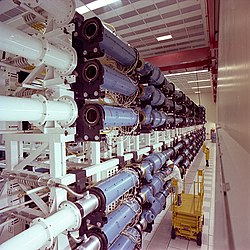
Back علم كبير Arabic Großforschung German Megaciencia Spanish Megatiede Finnish Big Science French महाविज्ञान Hindi Sains besar ID 巨大科学 Japanese 거대과학 Korean Didysis mokslas Lithuanian
This article has multiple issues. Please help improve it or discuss these issues on the talk page. (Learn how and when to remove these template messages)
|

Big science is a term used by scientists and historians of science to describe a series of changes in science which occurred in industrial nations during and after World War II, as scientific progress increasingly came to rely on large-scale projects usually funded by national governments or groups of governments.[1] Individual or small group efforts, or small science, are still relevant today as theoretical results by individual authors may have a significant impact, but very often the empirical verification requires experiments using constructions, such as the Large Hadron Collider, costing between $5 and $10 billion.[2]
- ^ "big science" Archived 23 April 2009 at the Wayback Machine, Merriam-Webster
- ^ Evans, Lyn; Bordry, Frédérick; Liyanage, Shantha (30 April 2024), Liyanage, Shantha; Nordberg, Markus; Streit-Bianchi, Marilena (eds.), "A Machine with Endless Frontiers: The Large Hadron Collider (LHC)", Big Science, Innovation, and Societal Contributions (1 ed.), Oxford University PressOxford, pp. 56–87, doi:10.1093/oso/9780198881193.003.0004, ISBN 978-0-19-888119-3, retrieved 8 June 2024
© MMXXIII Rich X Search. We shall prevail. All rights reserved. Rich X Search